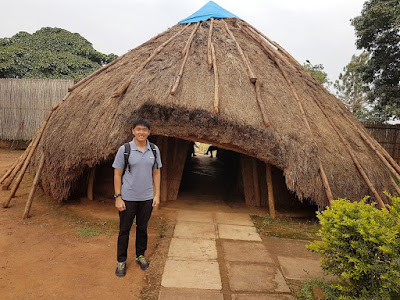JPN: Seven Hells of Beppu (Part 1)
Beppu, Oita, Japan
Daily: 8.00am - 5.00pm
Probably the most popular attractions of the hot spring town of Beppu, the so-called Seven Hells of Beppu are geothermal pools of various sizes and colours for viewing. Five of them are within walking distance in Kannawa district, while the other two are in Shibaseki district.
---
JPN: Hotel Sunline Fukuoka Hakata Ekimae
JPN: Nagahama Fish Market Centre
JPN: Korokan Ruins Museum
JPN: Maizuru Park
JPN: Ohori Park
JPN: Kushida Shrine
JPN: Tocho-ji & Shofuku-ji
JPN: Fukuoka Downtown
JPN: Fukuoka Uptown
JPN: Yufuin No Mori 3
JPN: Tenku Yubo Seikaiso
JPN: Seven Hells of Beppu (Part 1) <YOU ARE HERE!>
JPN: Seven Hells of Beppu (Part 2)
JPN: Beppu Downtown
JPN: Yufuin Kotobuki Hananosho
JPN: Yunotsubo Street
JPN: Kinrin Lake
JPN: Yufuin Downtown
JPN: Hotel Route-Inn Kumamoto Ekimae
JPN: Kumamoto Castle
JPN: Kumamon Square
JPN: Kumamoto Downtown
JPN: Tsubame 322 & Huis Ten Bosch 11
JPN: Hotel Okura JR Huis Ten Bosch
JPN: Town of Sasebo
JPN: Mameshiba Café
JPN: Huis Ten Bosch (Part 1)
JPN: Huis Ten Bosch (Part 2)
JPN: Nagahama Fish Market Centre
JPN: Korokan Ruins Museum
JPN: Maizuru Park
JPN: Ohori Park
JPN: Kushida Shrine
JPN: Tocho-ji & Shofuku-ji
JPN: Fukuoka Downtown
JPN: Fukuoka Uptown
JPN: Yufuin No Mori 3
JPN: Tenku Yubo Seikaiso
JPN: Seven Hells of Beppu (Part 1) <YOU ARE HERE!>
JPN: Seven Hells of Beppu (Part 2)
JPN: Beppu Downtown
JPN: Yufuin Kotobuki Hananosho
JPN: Yunotsubo Street
JPN: Kinrin Lake
JPN: Yufuin Downtown
JPN: Hotel Route-Inn Kumamoto Ekimae
JPN: Kumamoto Castle
JPN: Kumamon Square
JPN: Kumamoto Downtown
JPN: Tsubame 322 & Huis Ten Bosch 11
JPN: Hotel Okura JR Huis Ten Bosch
JPN: Town of Sasebo
JPN: Mameshiba Café
JPN: Huis Ten Bosch (Part 1)
JPN: Huis Ten Bosch (Part 2)
---
After putting our luggage in the coin lockers at Beppu railway station, my BFFs and I purchased two things: an exchange voucher for the entrance tickets to the Seven Hells of Beppu at ¥2,000 (~S$24.95) per adult and a one-day bus pass at ¥900 (~S$11.25) per adult. If you're short on time, you can enter selected hells at ¥400 (~S$6.25) each. Anyway, possibly for being able to speak Japanese rather fluently, we were in for a treat as we were given a bit of discount, but I shan't elaborate on that further.

We took Bus #5 to go to the Kannawa district.
 |
| Alternatively, you can also take Bus #2 and Bus #24. |
 |
| Umi Jigoku is the largest and the most popular in the Kannawa district. |
[Oniishi Bozu Jigoku]
Kannawa District, Beppu, Oita, Japan
We exchanged our voucher for the actual entrance tickets at the ticketing booth of Oniishi Bozu Jigoku. Don't forget to take a pamphlet with spaces for you to collect stamps from the various hot springs.
This particular 'hell', featuring grey mud pools, is named after the rising mud bubbles that are said to look like the shaven heads of monks.
 |
| The mud was bubbling pretty smoothly. |
 |
| The average temperature of each pool there is 99 degree Celsius. |
Take a look at the following two short video clips on the bubbling mud.
In addition, you can also see quite a spectacular view of steaming rocks there, which is called Oni No Takaibiki (lit. Snore of the Demon).
 |
| Enduring the sulfur smell~ |
Here's a video clip on the steaming rocks.
[Umi Jigoku]
Kannawa District, Beppu, Oita, Japan
Upon entering the area, the first thing that we saw wasn't the geothermal pools, but the serene lake surrounded by plants.
 |
| It must be even prettier in spring. |

Umi Jigoku (lit. Sea Hell) emerged more than 1,200 years ago after the volcanic eruption of Mount Tsurumi. Its average temperature is 98 degree Celsius.
 |
| Don't you love its light blue colour? |
Here's a video clip for you.
Literally meaning 'stove hell', Kamado Jigoku features a few geothermal pools.
Don't forget to take a look at the greenhouse.
 |
| That's a rather peculiar English translation. |
 |
| Those lotus leaves are able to support a child of up to 20 kg. |
There's a red-coloured geothermal pool nearby, as well as a place of relaxation for visitors to soak their feet.
Before leaving, we decided to try a delicacy called gokuraku manju (lit. paradise bun) priced at ¥500 (~S$6.25) per box. Filled with azuki (lit. red mung beans), they were soft with a nice balance of the sweet and the salty.
[Kamado Jigoku]
Kannawa District, Beppu, Oita, Japan
On the way from Umi Jigoku to Kamado Jigoku, we saw two interesting things: a fortune telling machine and a statue donated by the city of Yantai in Shandong, China to mark 20 years of friendship with Beppu back in 2005.
 |
| Make sure that you hold your child's hand and don't let him roam around by himself. |
 |
| The less impressive version of Umi Jigoku has a slightly lower average temperature of 90 degree Celsius. |
Why not have a sip of the hot spring water maintained at 80 degree Celsius? It didn't taste good to me though, and I kinda regretted mixing it with the remaining water in my water bottle.
If that doesn't sound appealing to you, you may want to inhale hot steam to nourish your throat and/or apply it on your skin. However, do be very careful as it's really, really hot.
Take a look at some amorphous silica retrieved from one of the hot springs.
Before leaving for the next 'hell', I bought a velvety egg pudding with sweet soy sauce at ¥350 (~S$4.35) and a hot spring boiled egg at ¥80 (~S$1.00).
 |
| While the egg tasted so-so, the soy sauce with yuzu pepper made it nice. |
Stay tuned for the next four 'hells' in the upcoming post!


































Comments
Post a Comment